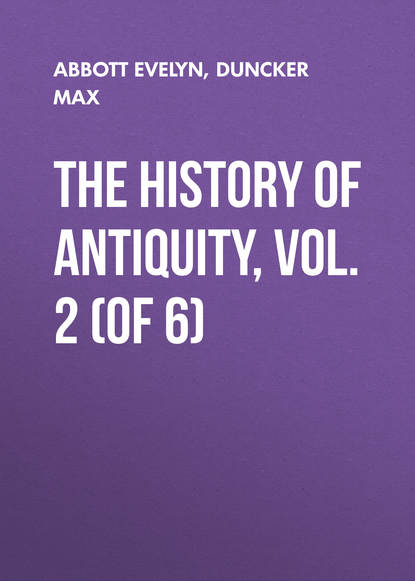По всем вопросам обращайтесь на: info@litportal.ru
(©) 2003-2024.
✖
The History of Antiquity, Vol. 2 (of 6)
Настройки чтения
Размер шрифта
Высота строк
Поля
435
Song of Solomon vi. 4.
436
1 Kings xv. 20.
437
1 Kings xx. 34.
438
Nöldeke, "Inschrift des Mesa."
439
Infra, chap. xi.
440
2 Kings iii. 4.
441
The inscription of Kurkh enumerates in the army of the Syrians at Karkar men from Ammon under Bahsa, the son of Ruchub (Rehob); Schrader, "Keilinschriften und A. T." s. 95.
442
2 Kings viii. 18.
443
1 Kings xxi. 1; xxii. 39; 2, ix. 15 ff.
444
1 Kings xvi. 31-33; xviii. 19; 2, iii. 2.
445
1 Kings xviii. 4-13, 17; xix. 10-14.
446
1 Kings xvii. 9, 10.
447
2 Kings i. 8; 1, xvii. 4-6.
448
1 Kings xviii. 17-46.
449
The objections which have been made against the assumption that the king of Damascus and Achabbu, against whom and their confederates Shalmanesar fought at Karkar, according to the monument of Kurkh (col. 2), were Benhadad II. of Damascus of the Books of Kings and Ahab of Israel are untenable. Shalmanesar II. marches four times against a king of Damascus; subsequently, four years after his last war with this king, he marches against a second king of Damascus, whose name in the inscriptions is indubitably Chazailu. In the Books of Kings Benhadad, Ahab's contemporary and opponent, is overthrown by Hazael, who becomes king of Damascus in Benhadad's place. Thus we obtain a certain basis for identifying the Benhadad overthrown by Hazael with the prince of Damascus against whom Shalmanesar fought four times. Hence on the reading of the name of this opponent of Shalmanesar in the inscriptions I cannot place special weight, especially as the Assyrian symbol for the deity in the name in question is well known to have more than one signification. If a further objection is made, that Ahab cannot have combined with Damascus against Assyria, but rather with Assyria against Damascus, in order to get rid of that opponent, the answer is that Ahab had reduced Damascus before Shalmanesar's first march against the city. Ahab had released Benhadad under a treaty (1 Kings xx. 34), and they "were at peace three years" (1 Kings xxii. 3). Hence at this moment Ahab was not in need of the assistance of Assyria. That free leagues are altogether inconceivable among the Syrian princes of that time is an assumption contradicted by numerous statements in the Egyptian monuments of Tuthmosis III., of Ramses II. and III., and yet more numerous statements in the Assyrian inscriptions. Not much weight can be allowed to the late and very general statements of Nicolaus in Josephus. If Nicolaus (Joseph. "Antiq." 7, 5, 2) calls the opponent of David Hadad, the Books of Kings do not mention the name of the king of Damascus against whom David contends. If he maintains that the grandson of Benhadad I., the third of the name, desolated Samaria, it is rather Benhadad I. of the Books of Kings, who was not the son and grandson of a Benhadad, but the son of Tabrimmon, and grandson of Hesjon, who first laid Samaria waste (1 Kings xv. 18-20). A second Benhadad contends with Ahab, who certainly may have been a grandson of the first, but certainly cannot have been the grandson of the opponent of David. If Nicolaus further tells us, that after Benhadad I. his descendants ruled for 10 generations, and each of them along with the throne received the name of Benhadad, this is contradicted by the Books of Kings, not merely in the genealogy of the first Benhadad of those books, but also in the fact that in them Benhadad II., the contemporary of Ahab and Jehoram, is overthrown by Hazael, who then in a long reign over Damascus inflicts severe injury on Israel and Judah. Hazael is followed in the Books of Kings by Benhadad III. That "Achabbu from the land of Sir'lai" is correctly read in the inscription of Kurkh is an ascertained fact.
450
The prophetic revision explains the overthrow of Ahab by the fact that he had spared Benhadad in the previous war, when Jehovah had delivered him into his hand.
451
Ninth and tenth year of Shalmanesar II.
452
According to Nöldeke, "Inschrift des Mesa," the upper city of Dibon.
453
1 Kings xix. 15; 2, viii. 7-15.
454
Joel iv. 19; Amos i. 11, 12.
455
2 Chron. xxi. 16-18; Amos i. 6; cf. infra, p. 260. n. 2.
456
2 Kings ix. 14.
457
2 Kings x. 12-14.
458
2 Kings xi. 1-3.
459
2 Kings x. 30. "To the fourth generation" may have been added by the revision post eventum.










